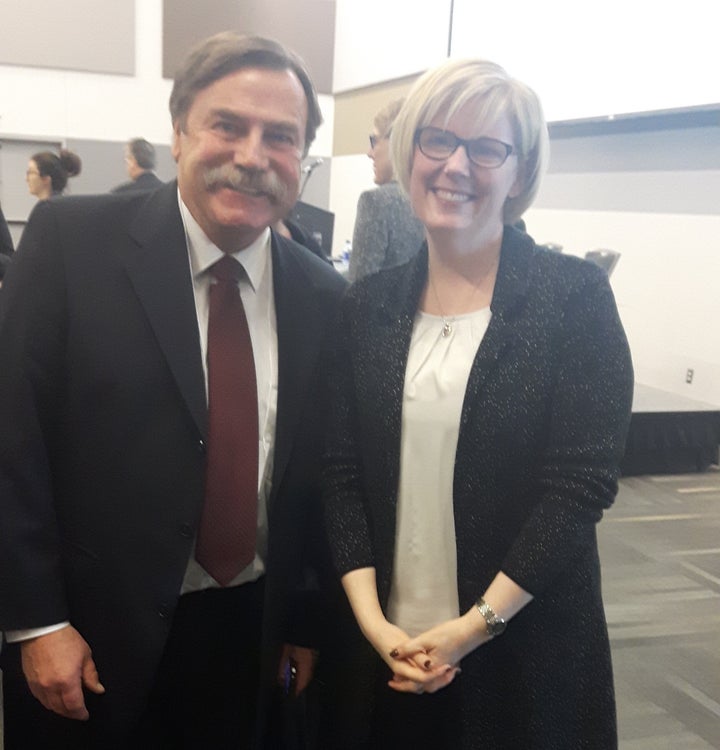Before the COVID-19 crisis, Kimberly Underhay volunteered for several organizations, including a disability resource centre in St. John’s. She cannot work but felt it was important to use her time to help her community.
Underhay has health issues related to surviving cancer treatment, lives with osteoarthritis, and uses a walker. But with the help of a personal support worker and relying on the Canada Pension Plan disability benefit, she was able to be fairly independent. But the pandemic has started to change that.
“Costs have gone up [for] basic groceries. I’m surprised with the cost,” she told HuffPost Canada. “Financially, there’s new drug fees that are coming out … and to get it delivered, there’s fees for everything.”
The accessible transit service she uses has been cut, so she’s travelling less frequently because of the increased cost of getting around.
The CPP disability benefit has not been raised during the pandemic. But because she receives that payment, Underhay does not qualify for most of the federal government’s pandemic-related relief programs like the Canada Emergency Response Benefit (CERB), or financial aid for seniors.
“I’m not quite that age, but I’m 53. They haven’t really been looking at us that much… They could put in some financial help like they did for seniors. For people on the disability pension, they could include them as well,” Underhay said.

She’s not alone in struggling without emergency pandemic support. Steve Lanys-Morris and his wife both have permanent disabilities — and a lot of experience navigating a “frustrating” and inefficient system.
In March, Prime Minister Justin Trudeau said no Canadian should suffer because of the pandemic. That was hard to listen to, said Lanys-Morris, because the government was acknowledging that circumstances were beyond people’s control — a status that encompasses all Canadians with disabilities.
“So effectively he said the minimum that people need [to live on] is $2,000 a month. Disability has a higher cost of living,” the 38-year-old said, adding that most Canadians with disabilities live off of much less than that, him and his wife included.
Specific plan needed
Canadians with disabilities make up 22 per cent of the general population, many of whom do not qualify for CERB, said Krista Carr, executive vice-president of the Canadian Association for Community Living, which works on behalf of Canadians with intellectual disabilities and their families. She suggested that at least 22 per cent of the $350-million federal fund for groups that support vulnerable populations should also go to disability organizations.
“There has not been a targeted financial announcement for people with disabilities in the same way there have been for others and I think that’s what’s needed right now,” she told HuffPost.
Current boosts like the increased child benefit are not sufficient to balance out the increased cost of living faced by people in the disability community, said Carr. She said the feds also need to work in harmony with the provincial and territorial governments for additional income supplements.
“We understand the federal government can’t do it all. They can’t do everything. But they can take leadership with the provincial and territorial governments to ... try to ensure that any financial benefits the federal government might announce aren’t clawed back by provinces and territories if the individuals are receiving provincial income assistance.”

Patrick Curran, the national executive director for Independent Living Canada, which supports inclusive rights and accessible services for Canadians with disabilities, said the coronavirus crisis has exposed the government’s ability to address long-standing problems.
“If there’s one thing about this pandemic that has come to light is that when there’s a need to find the money to help Canadians deal with a very serious problem, the money is down. ‘OK, we worry about how it gets paid later’… To me, it’s quite obvious that more money should have been spent in the past towards people with disabilities,” said Curran.
Marielle Hossack, a spokesperson for Disability Inclusion Minister Carla Qualtrough, said many of the government’s existing programs, such as the CERB and the GST credit, cover a large number of Canadians with disabilities.
“For example, 70 per cent of Canadians eligible for the disability tax credit will receive the enhanced GST/HST benefit, which effectively doubles the maximum amount available to recipients for the 2019-20 fiscal year, because of their income levels,” Hossack said in a statement to HuffPost.
“They always seem to be the last ones to get attention and for such a huge population of people, I always wonder, why is that?”
- Krista Carr, Canadian Association for Community Living
The government set up the COVID-19 Disability Advisory Group to keep in touch with experts in disability inclusion and how people with disabilities are doing during the crisis, she said, and the minister is meeting with the group regularly.
“We have been making great strides in breaking down barriers for Canadians with disabilities over the last few years,” said Hossack. “Our government knows there is more work to do and we will continue to work towards greater disability inclusion in everything we do.”
But Carr feels the community hasn’t been heard very well during the pandemic.
“They always seem to be the last ones to get attention and for such a huge population of people, I always wonder, why is that? People with disabilities are our workers. They’re our friends. They’re our neighbours.”
The imagery around the people most susceptible to the virus has been misleading, Curran adds, because it is centered on seniors who live in long-term care facilities, when the reality is those individuals are also part of the disability community.
“The older you are, the more likely you are to have a disability… They have it wrong, because it’s about people with disabilities, not people who are vulnerable, or people that are older. It’s people with disabilities that are most vulnerable to COVID-19.”
Exposes a broken system
The pandemic has only further exposed the need for Canada to address the chronic underfunding of services for people with disabilities, said William Cowie, an economist and the founder of the Every Canadian Counts Coalition, which advocates for an Australian-style program.
“If we have something like the Australians had in the form of a Medicare-type support system for persons with disabilities, it would mean that additional income that they would get would not have to be spent on support services, because the insurance program would provide them with those services. So it’s a prerequisite to an income program which would help get them out of poverty,” Cowie said.
Such a system would include a component to manage risks like a pandemic, he said.
“But right now, we have no systematic approach at all. And, as a consequence, we’re hung out to dry.”

Disability activist Jonathan Marchand, 43, has been fighting for systemic change for years. He lives in a long-term care home in Sainte-Anne-de-Beaupré, outside of Quebec City. He agrees with Cowie that a federal insurance program would relieve a lot of issues.
“When we talk about the lack of support for caregivers, when we talk about the pressure on our health-care system, when we talk about the condition, the living conditions in long-term care facilities, those are all issues that are related to the lack of support of people with disabilities. It would resolve a lot of issues, not only with people with disabilities, it would make Canadian society a lot more healthy on the social and physical aspect as well,” said Marchand, who has muscular dystrophy.
Curran said the Liberal government has shown more interest in supporting Canadians with disabilities than the past few governments, but a lot is still lacking.
“There’s a lot of improvements that still need to be made. But I think COVID-19 has helped shape the lens to be a little more acute,” he said. “I think the government is realizing that people have greater needs to be on an equal playing field as everybody else.”
CORRECTION: An earlier version of this story spelled Krista Carr’s last name as “Car”. This has been updated to reflect the correct spelling.
Also on HuffPost: